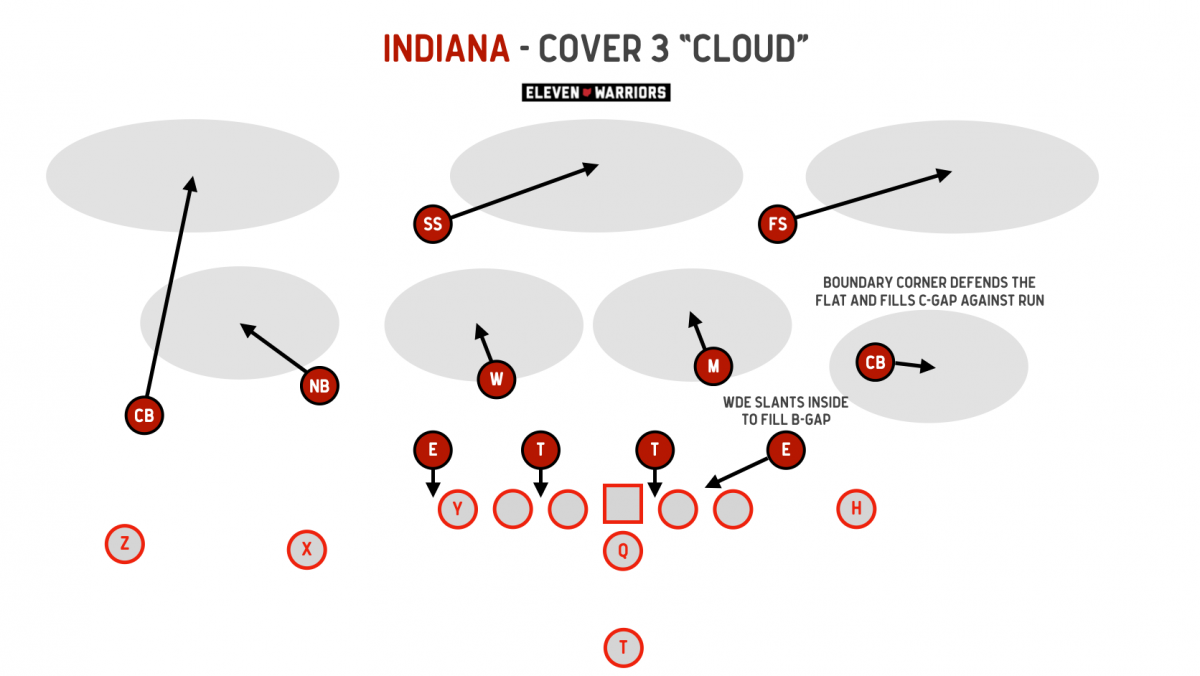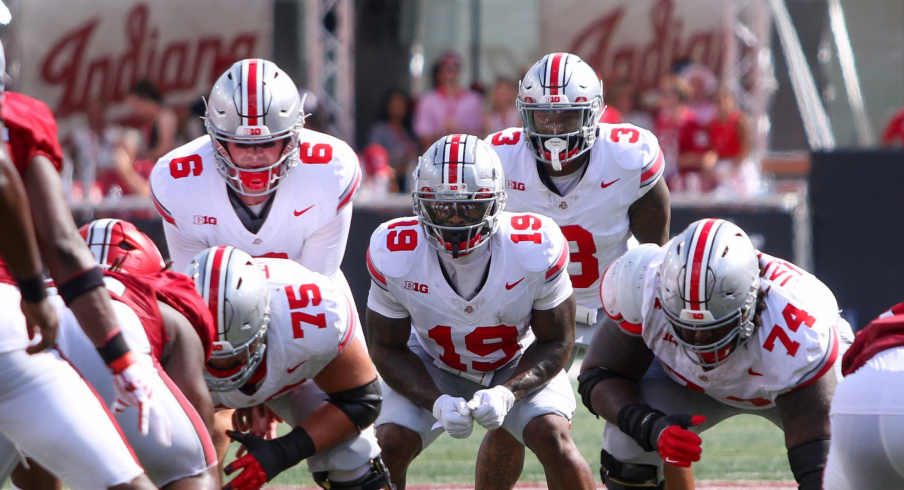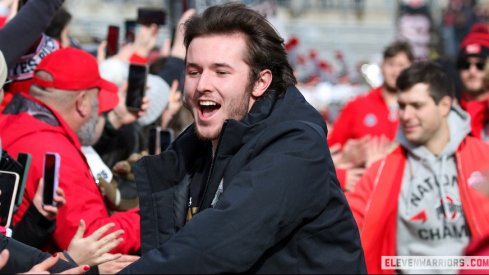It's always Jim Knowles' fault.
As has been the case on numerous occasions over the past three seasons, Ohio State failed to look impressive on both sides of the ball in its 23-3 win over Indiana to open this year's campaign. And although Knowles' defense surrendered just 153 yards in a dominant showing, he still somehow bears some of the blame for some of the Buckeyes' offensive struggles last Saturday afternoon.
For it was Knowles, after all, who hired Matt Guerrieri as a senior analyst last season. As many of us now know, Guerrieri coached with Knowles at Duke and took over as co-coordinator when his boss left for Oklahoma State, only to be named to the same position at Indiana this past winter.
The challenge of breaking in a new quarterback and three starters along the offensive line, in a conference game on the road in week one no less, wasn't enough for Ryan Day and his offensive staff. They'd also have to do it against an opposing play-caller who was intimately familiar with their philosophies and tendencies.
Based on what we saw from Guerrieri's Hoosier defense, it appears as though the Willoughby native paid close attention during his brief stint back in his home state.
Guerrieri seemed intent on taking away the Buckeyes' most common run concept as well as its two biggest threats on the outside. By playing Cover 3, IU could get an extra body in the box to defend the run. But they played a version of the scheme known as Cloud, in which the boundary corner didn't drop into coverage, staying underneath and defending the edge instead.

While this proved effective at stymying the Buckeyes' long-preferred method of running the ball - Outside Zone into the boundary - it was deployed in a way that would also help defend the talented OSU receivers. If the offense lined up with two tight ends, the IU defenders aggressively helped outside when dropping into pass coverage, effectively double-teaming Marvin Harrison Jr. and Emeka Egbuka and forcing Kyle McCord to look elsewhere.
But although Harrison Jr. and Egbuka had quiet performances that afternoon, Buckeye tight ends consistently made plays in all the open space that opened up between the hashes.
Cade Stover led all Ohio State receivers with 98 yards through the air, with four of his five catches coming in the middle of the field. While he and Gee Scott Jr. (who played a career-high 33 snaps) are listed as tight ends, both players showed why they were athletic enough to be recruited at other positions before settling into their current roles.
This athleticism proved particularly vital when OSU broke the huddle with two tight ends. Stover and Scott created mismatches against the Hoosier defenders who struggled to keep up in coverage as the rest of their teammates focused on the outside receivers.
“It was a good play-action play call, got the linebackers to bite," Stover said of his longest catch of the day. "I got lucky, got put in a good position to do well.”
Initially, it appeared as if these looks were packages designed simply for short-yardage and red-zone situations, such as the early completion to Scott on 4th-&-2 in which everyone in Memorial Stadium seemed focused on Harrison, Egbuka, or running back TreVeyon Henderson.
But few could have expected to see them line up with multiple tight ends, running backs, or both, as often as they did against the Hoosiers. While it's unclear how much of this usage was in response to Guerrieri's game plan, what is clear is that 12 personnel sets were devastatingly effective all game long.
| Personnel Package | No. of Snaps | Total Yards Gained | Average Yards per Play |
|---|---|---|---|
| 11 (1 RB, 1 TE, 3 WR) | 37 | 163 | 4.4 |
| 12 (1 RB, 2 TE, 2 WR) | 22 | 183 | 8.3 |
| 13 (1 RB, 3 TE, 1 WR) | 3 | 8 | 2.6 |
| 21 (2 RB, 1 TE, 2 WR) | 2 | 10 | 5.0 |
| 22 (2 RB, 2 TE, 1 WR) | 5 | 16 | 3.2 |
| 00 (0 RB, 0 TE, 5 WR) | 1 | 0 | 0.0 |
The Hoosier game plan was a solid one, unleashing end Andre Carter (#1) and linebackers Aaron Casey (#44) and Jacob Mangum-Farrar (#7). The trio was consistently in the backfield breaking up run plays as Guerrieri had them prepared for the Buckeyes' base run schemes.
But this aggression was a double-edged sword, as the middle of the field was wide open on play-action passes, leading to what may have been McCord's best throw of the day. As the Buckeyes lined up in 12 personnel, the Hoosiers clearly anticipated another run, with the linebackers slow to get to their zone drops and allowing Julian Fleming to race across the middle for a big gain.
Eventually, the Buckeyes found ways to neutralize the ultra-aggressive linebackers and run the ball, once again due to changing their personnel. Yet another player who changed positions throughout his career found himself playing a major role in the OSU offense, as Chip Trayanum saw the field at tailback, fullback, and even as an off-ball tight end against IU.
While he first saw time in the backfield as an I-formation fullback ahead of Miyan Williams, he also helped Henderson finally find a seam while running Outside Zone by acting as a lead blocker.
“I just like being on the field regardless, and I’m a competitor," he told the media this week. "So whatever role I can compete and maximize on the field, that’s what I’m gonna do.”
But Trayanum emerged as a fan favorite last weekend thanks to his ability to see creases as a runner himself. With the Hoosiers overplaying the outside zone scheme on the perimeter, anticipating (correctly) that Henderson would often bounce it outside, Trayanum quickly recognized a cutback lane inside after taking a second-half handoff.
It was his ability to see and execute Counter schemes that stood out most, however. After years of the Buckeyes relying too heavily on zone blocking, they found success when the backside guard and tight end pulled across the formation to lead a ball carrier, running the play 4 times for a whopping 62 yards.
With the Hoosier linebackers reading the offensive line's initial steps, the down-blocking, play-side linemen held the defenders just long enough to allow the pullers to get around and create a seam for Trayanum. Once in the open field, the former linebacker proved nearly impossible to take down one-on-one.
Just as throwing to tight ends over the middle was Ohio State's most successful method of moving the ball through the air, Counter proved the same when running it. While some might have been disappointed with this turn of events, preferring instead to see the receivers make countless plays on the perimeter while Henderson turned the corner in the run game, it may have been a blessing in disguise.
Guerrieri was intent on keeping the OSU offense from executing its core concepts, relying on his intimate familiarity with the system to design a game plan that would force his opponent to effectively play 'left-handed.' In that sense, the plan was successful, as it took away the Buckeyes' preferred schemes and forced them into a number of early mistakes.
“I don’t see anything on the film that isn’t correctable, like guys just getting flat-out beat or not (being) good enough,” Day said of his offense's performance this week. “That is the most encouraging thing. I think they are things that can get corrected. Would have loved to see better execution but the things that we’ve seen there are all correctable.”
Despite an error-prone offensive line and a new quarterback, the Buckeyes still moved the ball when they took advantage of the opportunities presented to them.
The offensive line should find its rhythm in the next two weeks and McCord should gain confidence with more playing time, just as his predecessor did two years ago. But having more options to turn to - both in scheme and personnel - should pay dividends over the long term and potentially unlock even more ways for an offense with incredibly high standards to find new ways to light up the scoreboard.



